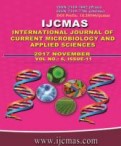


 National Academy of Agricultural Sciences (NAAS)
National Academy of Agricultural Sciences (NAAS)

|
PRINT ISSN : 2319-7692
Online ISSN : 2319-7706 Issues : 12 per year Publisher : Excellent Publishers Email : editorijcmas@gmail.com / submit@ijcmas.com Editor-in-chief: Dr.M.Prakash Index Copernicus ICV 2018: 95.39 NAAS RATING 2020: 5.38 |
The present study was conducted at College of Horticulture, University of Horticultural Sciences Campus, GKVK, Bengaluru during 20014-15. The experimental material comprised of bacterial wilt resistant variety, Anaga and susceptible variety, Vaibhav. The seeds from F1 hybrid derived from the cross involving Anagha x and Vaibhav, were used in a previous study at College of Horticulture, UHS Bengaluru, this cross combination was identified for F1 being resistant and productive and a genetic analysis involving these two parents also revealed monogenic/oligogenic nature of inheritance for bacterial wilt (Jyothi et al., 2013) and All the F2 individual plants of Anaga x Vaibhav were advanced to F3, F4, F5 and F6 generations following the Single Seed Descent (SSD) method for attaining homozygous and heterogeneous RIL population. The experiment was laid out in Randomized block design with three replication, further the F6 families of all the individual plants were evaluated in sick plot conditions to ascertain their segregation pattern for the incidence of bacterial wilt disease. Result on bacterial wilt showed that out of 300 F6 populations 61 Recombinant inbreed lines were resistant and 69 were susceptible for bacterial wilt disease incidence under sick field condition.
 |
 |
 |
 |
 |